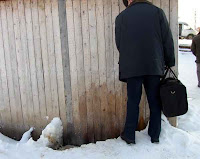Remember The 80’s? Michael Jackson
One day I was
researchinglooking at pictures of Michael Jackson’s 1984 Victory Tour which launched in Kansas City and then I saw this:
This piece of art was published in a special issue of the Billboard Magazine where everyone from Michael’s accountant to the company which made his tapes took out ads to congratulate Michael Jackson (and slap their own backs in the process)on becoming the King of Pop.
After the first picture I just couldn’t stop. Sorry…
Continue reading →Master and Margarita At The UMKC
After reading an article in the Pitch imploring me to see the Master and Margarita at the UMKC I knew I had to go. The Master and Margarita is one of only a few books that I read more than once and discovered something new every time. It is also one of a few Russian masterpieces that no matter how well translated could not be fully understood by a foreigner (that would be you); it’s somewhat similar to me trying to decipher Cris Packham’s pop-cultural references (not that I don’t try). The book was written during the times of the strictest censorship when even a hint of anti-Soviet criticism could literally threaten the writer’s life and that’s why Mikhail Bulgakov had to insinuate just as much as he wrote down. The average Soviet reader could easily read “between the lines” and see the satire in the most innocent dialogues and descriptions. Some of the references were to the specific characters in the author’s life and are not easily recognizable but the barbs thrown at the Soviet bureaucrats, censors, informers, dimwits, careerists, sellouts and the regime itself were obvious to the people who still encountered them in their everyday life for another 50 years after the book was written.
Not too many people risked producing it on the stage or on the screen, it could not be easily condensed and the characters were so well-known and beloved that any such attempt would be criticized by the fans. That’s why I was pretty skeptical going to the UMKC performance. I didn’t expect the cast to have an understanding of the book required to convey it onto the stage and it couldn’t possibly be shortened to fit into the regular length of the theater performance. What I saw was pretty amazing and truly one of the best theatrical performances I’ve seen in my life – honest, funny, enthusiastic, smart, inventive and, although not very close to the book, with plenty of Blugakov’s spirit in it. Once you get past the fact that some male roles are played by girls (i.e. Koroviev and Azazello), the character of the devil – Woland is wearing hooves, and the Cat Behemoth is a black guy with the red Mohawk dressed in some kind of leather corset and a shaggy trench coat, everything else falls in place. The actors were outstanding but Patrick DuLaney who played Woland was on par with the Russian actors who played this role in the movie versions of the Master and Margarita. He was able to convey Woland’s millenniums-old age, his exhaustion with life, his disgust with people which could only be defeated by the true love and selfless sacrifice. Julane Havens as Margarita was also very impressive, as a sensitive, sensual, defenseless but determined woman ready to sacrifice everything just to be with Master. The actress who played Hella gets a special mention, nice job keeping every male eye locked on the stage!
I also would like to specifically praise the costume and stage design. The Soviet people are all dressed in the same gray uniforms lovingly adorned by red stars; even their underwear is gray (as was revealed later and you missed it). I also liked the use of projection screens.
During the show I (illegally) made a few videos, sorry, serious-looking-bearded-usher-guy, I didn’t spend years in the KGB school in the USSR to be told what to do by the Man.(By the way, in the bottom part of these videos you’ll see a jackass who didn’t feel it was necessary to take his stupid hat off in the theater; maybe the usher should have concerned himself with this view-obstructing clown instead of making sure I can’t record a low-quality video.)
httpvh://www.youtube.com/watch?v=WPQqevnTdiw
httpvh://www.youtube.com/watch?v=Sw9F3GrppVM
httpvh://www.youtube.com/watch?v=mOpHIxKJqdk
After the show I overheard one lady ask her friend if she enjoyed the show, “it was too weird” was the reply. It’s hard to convey the whole complexity of the book on the stage to an unprepared viewer, but to people who understood it was an amazing effort worthy of a professional venue.
P.S. Alan Scherstuhl is my new Facebook friend on the condition that I will never have to pronounce his last name.
Continue reading →Holocaust Remembrance Day: Extermination of Odessa Jews
The Holocaust Remembrance day falls on May 2 this year and in the few following posts I will publish several documents concerning the treatment of the Jewish population in my hometown of Odessa, Ukraine issued by the Romanian Authority which occupied Odessa from 1941-1944.
At the beginning of the occupation there were 80,000-90,000 Jews who did not evacuate from Odessa. When the city was liberated on April 10, 1944 there were reportedly only 600 left. Somewhere in the Odessa Region my 6-year old Father survived in the ghetto with help from kind people and lots of luck. The area where he lived with my Grandmother was occupied by the Italians who were not very enthusiastic about being in the war and their relative reluctance to torture and execute the Jews might have resulted in more survivors than in the areas controlled by Romanians who proved themselves to be ruthless murderers.
Many places in Odessa and the Region have memorial markers where the executions were conducted, such as a place where over 25,000 Jews were burned alive shortly after the occupation started. Unfortunately, I never stopped or paid attention to them, probably like most people. I saw more memorial markers today, while researching this post, than I remember seeing when I still lived in Odessa.
The Russian text is found in the National Archives of the Odessa Region, translation mine. If I have time and patience I will also try to translate a personal memoir written by a survivor; translation is a long and tedious process, and even though I start with a machine translation, it still doesn’t always come out right. Feel free to let me know if I can correct some grammar or spelling errors.
Continue reading →Behind The Iron Curtain – #1 and #2
Some production notes: this will conclude my ground–breaking series on this subject. I received requests not to link self-respecting bloggers to posts of this nature, all I can say is some people don’t recognize greatness when they see it. I would also take requests for subjects you’d like me to cover in the future.
 The last installment will just tie up some loose ends. Enough with crappy puns, we are moving on to the subject of:
The last installment will just tie up some loose ends. Enough with crappy puns, we are moving on to the subject of:Public restrooms.
The one thing that stands out about public restrooms is that there weren’t that many. There were few maintained by the city in the parks and other public places and that was it. Public restrooms were just as dirty, nasty and smelly as you would imagine. But so were every dark corner and every hallway in apartment buildings that couldn’t be locked.
 Citizens who did not exercise total control over their bladders and bowel movements found other ways to express themselves. The stench was legendary. The problem was made worse by the fact that there was no fast food or other public places where a person could stop by in case of emergency. Even some popular comedies and jokes of that time depicted someone knocking on the random apartment door and offering money just to be able to use the restroom. Every soviet citizen got the joke. I myself was in a similar situation, although it didn’t seem that funny when I had to do it.
Citizens who did not exercise total control over their bladders and bowel movements found other ways to express themselves. The stench was legendary. The problem was made worse by the fact that there was no fast food or other public places where a person could stop by in case of emergency. Even some popular comedies and jokes of that time depicted someone knocking on the random apartment door and offering money just to be able to use the restroom. Every soviet citizen got the joke. I myself was in a similar situation, although it didn’t seem that funny when I had to do it.
After the perestroika many public bathrooms became privatized. Newly minted attendants collected a fee, dispersed toilet paper, cleaned and freshened the air. 20th century luxuries finally made it into the USSR but the country didn’t last very long after that. Maybe the whole foundation of the Soviet system was based on the toilet hardship.
Epilogue:
Continue reading →
Long time ago I realized that my daughter cannot pee without a toilet. As a father I am not sure how to explain the process and describe what needs to be done. I tried to talk my (then) wife into teaching this necessary life skill to a child but all I got is a shrug. I am awaiting in horror when during one of our driving trips we would not be able to find a restroom. On one hand, I am glad the the restroom problem is solved here and my kid will not to have to use one of the smelly, nasty and slimy restrooms of my youth. On the other hand…Personal Recollections Of The Terrible Kansas Blizzard of 1886
We interrupt our tropical coverage to bring you this gripping account of the Blizzard of 1886 (or as we call it in present “Tuesday”)
Continue reading →